During 2022, as a result of Madrileña Red de Gas’ commitment to the energy transition process, we have participated in interesting innovative projects, whose medium to long-term objective is to transform our natural gas distribution network into a network of renewable gases such as H2 and to be a clear alternative in this transition.
These projects include the Inspira Madrid project,for mobility with green hydrogen in the Community of Madrid, the Pryconsa project, for the use of renewable hydrogen to cover heating and SHW needs, and the Cavendish2 project, aimed at studying the competitiveness of renewable gases and their role in the energy transition.
In relation to NGV, for yet another year, the consumption of natural gas as a fuel for mobility has continued to increase. Finally, it should be noted that, under our commitment to fight climate change, we have once again calculated and verified our carbon footprint, according to scopes 1, 2 and 3.
Natural Gas Vehicles (NGV)
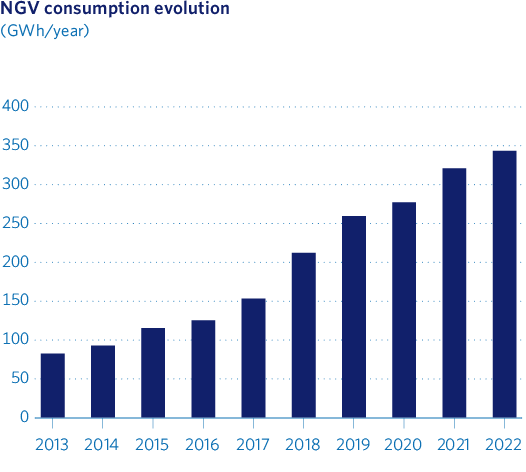
Therefore, there are already 19 NGV stations connected to the Madrileña Red de Gas networks, and in the coming months this number will exceed twenty
During 2022, despite the price variations caused by the unfortunate events that occurred during the year, the consumption of natural gas as a fuel for mobility has continued to grow. This has been helped by the stabilization of prices that has returned to the gas market since the last months of the year, returning to the previous situation of significant economic savings compared to other fuels.
Two new public access NGV refuelling stations have been opened in 2022, one in Alcorcón and the other in Móstoles.
Both municipalities in the southern periphery of Madrid have around or more than 200,000 inhabitants with a great need for mobility of people and goods.
These openings facilitate access to an efficient and economical fuel for potential users who need environmentally sustainable transport for access to the capital or the upcoming Low Emission Zones to be implemented in both municipalities.
It will also be feasible for fleets and individuals to be supplied at these or other biomethane stations, given the imminent implementation of Guarantees of Origin (GoO) in the gas sector.
A vehicle using biogas would be to all intents and purposes zero emissions and therefore perfectly comparable to vehicles with combustion engines using environmentally friendly fuels. The engines do not pollute, the fuels pollute, and in this field NGV, in its conventional version, is the fuel with the lowest CO2 emissions (global pollution) and practically zero local pollutants (mainly NOx and particules). In its bio version, as mentioned above, it would have a zero CO2 balance. More than 12 GWh of biomethane have already been consumed in road transport during 2022.
Therefore, there are already 19 NGV stations connected to the Madrileña Red de Gas networks, and in the coming months this number will exceed twenty.
The NGV fleet in Spain amounts to 34,879 vehicles, it should be noted that nearly 50 % of the registrations take place in the Community of Madrid. There has been an increase in the registration of industrial vehicles and buses. The existing gas stations can be consulted on the GASNAM website (https://gasnam.es/terrestre/ mapa-de-estaciones-de-gas-natural/).
Environment
In the environmental area, the system of environmental performance indicators has continued to be maintained, and progress has been made in perfecting the event-based methodology for estimating fugitive methane emissions from the distribution network, separating Scope 1 and Scope 3 emissions, the result of which is taken into account in the corresponding carbon footprint report.
During the year 2022, MRG’s carbon footprint scope 3 has been calculated for the first time and a report has been prepared under the ISO 14064 standard and verified by an independent third party.
Finally, this carbon footprint report has been notified to the Spanish Climate Change Office and has been awarded the “CALCULO” label for 2021.
In addition to its calculation and verification, we have established a clear commitment to its reduction, carrying out different strategies, such as a proposed Mitigation Plan aligned with the “Fit for 55” targets for 2030 and “Net 0” for 2050, among others.
On the other hand, the notification of the contaminated soil reports of the decommissioned LPG plants has continued at a good pace, and many of the owners of these soils have been notified of the conclusions of the administrative resolutions related to this process.
It should be noted here that MRG continues to work and improve its performance with the aim of maintaining the certifications of its Integrated Management System for Prevention, Environment and Quality (SIG) according to the ISO 45001, ISO 14001 and ISO 9001 standards respectively.
In addition, as mentioned above, a new section on “Sustainability” has been developed on the MRG website, where the organization’s commitment in this area is shown and performance results are reported: https://madrilena.es/sostenibilidad/.
Finally, it is worth mentioning that a clean point has been created at the new work center in Alcorcón, both for the management of Solid and Urban Waste, through the service designated by the City Council, as well as for Hazardous Waste, by requesting the NIMA code (Environmental Identification Number) from the Community of Madrid, which unequivocally identifies each waste-producing activity.
The environmental performance of Madrileña Red de Gas, as well as the results of its emissions, consumption, waste and other environmental aspects derived from its activity, are included in the Sustainability Report for the year 2022, prepared and verified in accordance with GRI standards, as mentioned above.
Inspira Madrid Project
Madrileña Red de Gas, together with FRV, and Grupo Ruiz, and the collaboration of the Professional Taxi Federation of Madrid, will participate from 2021 in the most important green hydrogen mobility project in the Community of Madrid at present. The objective is to participate in the hydrogen value chain, seeking to decarbonize the urban public mobility fleets of Madrid, being a unique project in this Community.
The project proposes the initiative in Madrid, given that land transport in this Community is one of the biggest climate and environmental problems, accounting for 55% of the region’s CO2 emissions and being one of the main agents causing the growing problem with pollutant emissions.
In the current context of energy transition and decarbonization of the economy, the Inspira Madrid project proposes to tackle this situation head-on through the decarbonization of urban public mobility fleets using green hydrogen.
This initiative will place the Madrid region at the international forefront of mobility and clean transport, as well as a benchmark in the national Hydrogen Roadmap (contributing to the objectives of 4 GW of electrolysis capacity and 100-150 public hydrogen plants by 2030), contributing to the entire value chain from the infrastructure for its generation and supply to the promotion of its consumption by the transport sector.
During the development of the project, new alternatives have been explored and the green hydrogen that will be produced in the project will be dedicated to both mobility and industrial use.
Among these collaborations is the strategic support of the Professional Taxi Federation of the Community of Madrid (FPTM) in the progressive decarbonization of the sector. In this context, work is being carried out with Toyota Spain to develop an innovative business model for the implementation of a new hydrogen fuel cell vehicle in the taxi sector.
Hydrogen fuel cell vehicles provide value and above all solutions to the question that more and more taxi drivers are asking themselves: which car to buy to access Madrid?
Given the increasing limitations of combustion vehicles in accessing the city center, the use of hydrogen is presented as a solution to the inherent limitations of the battery electric vehicle, allowing a longer range and shorter refuelling time.
In addition, we have the commitment of Grupo Ruiz, specialized in urban mobility by bus, the support of Grupo SEUR, a leading company in national logistics that is undergoing an ambitious process of decarbonization of its fleet, the municipal waste collection company of Getafe LYMA and the cash-in-transit management group LOOMIS, with all the main methods of mobility in the region being represented in this project, both for people and goods.
Inspira Madrid desplegará la infInspira Madrid will deploy the renewable hydrogen production and supply infrastructure through a network of 5 publicly accessible hydrogen plants (HRS), in a first phase, which combined will supply light and heavy vehicles at a competitive price compared to conventional fossil alternatives.
This project will be undertaken with a modular, flexible and adaptable approach that allows for scalability in successive phases of expansion.
Public support for the project
During 2022, Inspira Madrid has applied for two of the main Next Generation EU funding programs.
The MOVES II Program for Incentives for Efficient and Sustainable Mobility and the H2 PIONEERS program, together with the renewable hydrogen industrial value chain programs, were the first lines of aid for the promotion of renewable hydrogen approved by the Ministry for Ecological Transition and the Demographic Challenge (MITECO) as part of the Strategic Project for the Recovery and Economic Transformation of Renewable Energies, Renewable Hydrogen and Storage (PERTE ERHA).
In addition, the consortium is working on the presentation of the project for the European Union grants corresponding to the CEF Transport program (Connecting Europe Facility), aimed at financing infrastructures that promote the development of the Trans-European Transport Network.
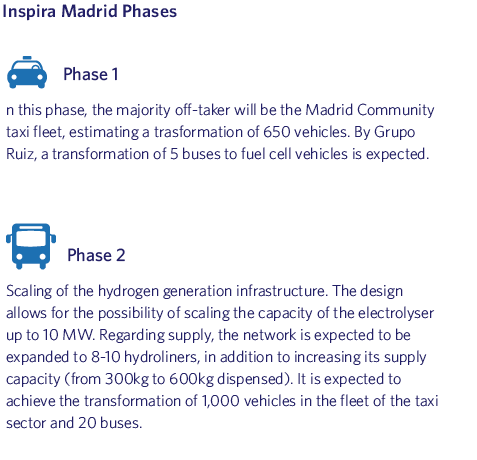
In the current context of energy transition and decarbonization of the economy, the Inspira Madrid project proposes to tackle this situation head-on through the decarbonization of urban public mobility fleets using green hydrogen
Pryconsa Project
Madrileña Red de Gas, in its efforts to enhance the value of the existing gas distribution network, a heritage belonging to all of us, began in 2022 to search for projects that would incorporate our network into the European effort to decarbonize and use hydrogen.
That is why, this year, the introduction of hydrogen in our homes was launched. In addition to its use in mobility, MRG is committed to the use of this energy vector for heating our homes.
Renewable hydrogen is positioned as one of the alternatives to contribute to the decarbonization of the domestic and tertiary sector, thanks to its capacity to provide a flexible, adapted and continuous energy supply. Currently, the application of hydrogen for thermal uses is only presented in the form of demonstration projects.
Between 2010 and 2020, heating and domestic hot water accounted for 60.3% of energy consumption in the residential sector. The energy sources to supply this demand are mainly natural gas and electricity.
This concern to find alternatives to natural gas is something that is not only happening in Spain. Pioneering projects similar to the one to be carried out in Spain are also being carried out in other European countries.
Among the choice of decarbonized gases, hydrogen is attractive for many reasons, mainly because it generates no greenhouse gas emissions at the point of use, and its combustion generates only water vapor.
Hydrogen poses many challenges, both technical and regulatory, but MRG is clear in its commitment to this gas. Together with Pryconsa, one of Spain’s leading housing developers, an agreement was signed to provide hydrogen to a new building and use it to cover heating and DHW needs.
Project description and outline
Specifically, the project will cover the heating and SHW needs of a 98-home development in Valdemoro, whose construction will begin in 2023.
- Hydrogen production
The hydrogen used, estimated at 25 tons per year, will be produced externally to the project. This hydrogen will be generated by renewable energies, thus qualifying as green hydrogen and contributing to the decarbonization of housing. - Hydrogen transport
Once produced, the hydrogen will be transported
by means of mobile containers to the refueling and injection station located in the vicinity of the homes. This infrastructure is where the main hydrogen storage will be located, consisting of tanks containing hydrogen in gaseous form and under pressure. - Storage
These tanks are sized to contain a reserve of hydrogen sufficient for several days of maximum consumption by the homes, thus guaranteeing their supply. As the homes demand the hydrogen, it will be odorized before it is released and injected into a hydroduct built for the project, which will communicate the storage with the housing development. - Usage
EThe hydro-product, after travelling the distance between the housing units and the storage, will end up in the building’s connection. Here, the hydrogen will be fed to the centralized boiler room of the housing development.Heat generation for heating and SHW will be provided by a central boiler, consisting of a roof-top unit prepared for both natural gas and hydrogen.
This centralization will allow the hydrogen to be used efficiently and safely. By taking advantage of its low density, any leakage of the gas will be directed to the top of the building and escape without causing noticeable concentrations.
The use of hydrogen will make it possible for all heat production in housing to be provided by a clean, innovative energy source without dependence on other countries.
Hydrogen is attractive for many reasons, mainly because it generates no greenhouse gas emissions at the point of use, and its combustion generates only water steam
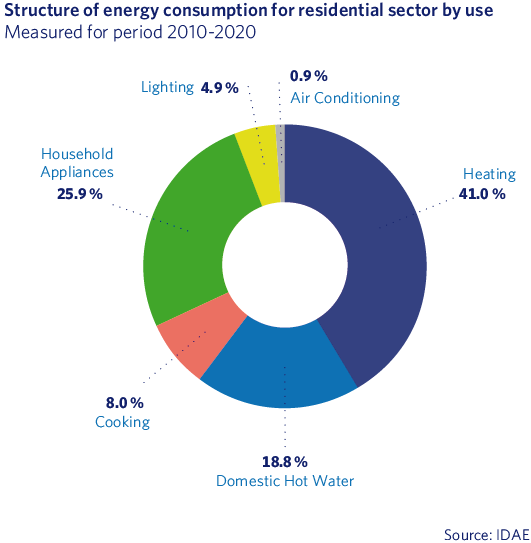
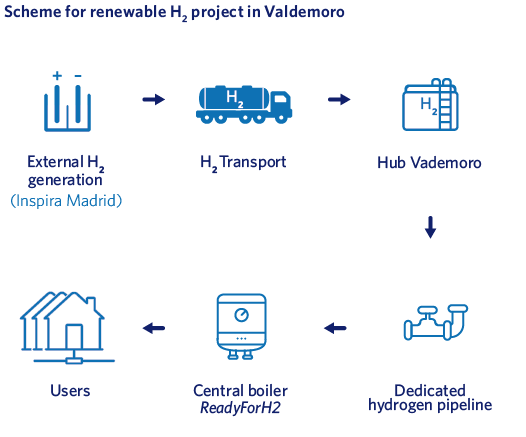
CavendisH2 Project
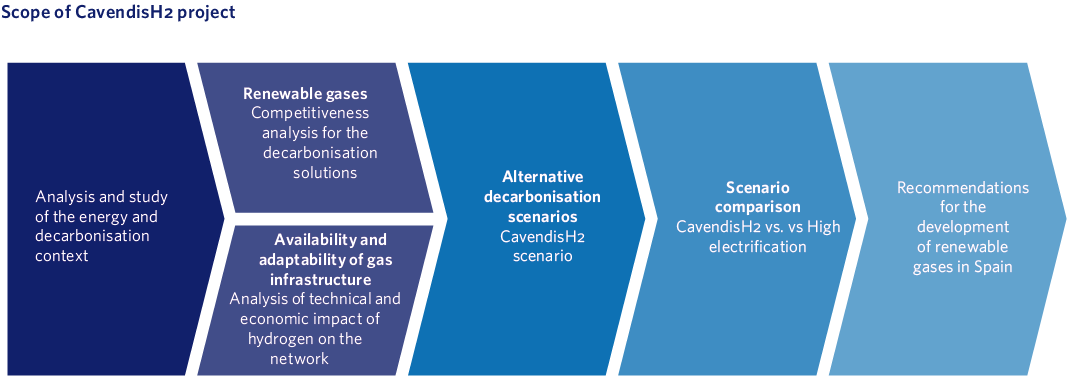
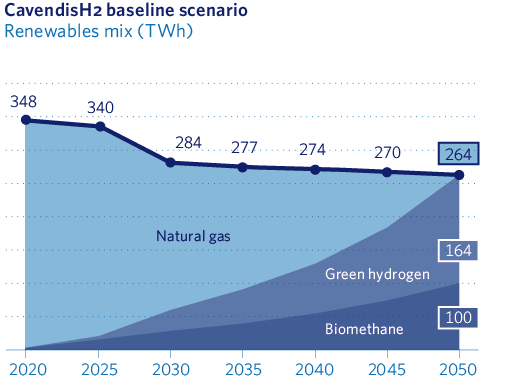
The study includes the feasibility of using existing gas infrastructure to supply different types of renewable gases, including blending of up to 20% and 100% hydrogen by volume, as well as the costs of adapting it if necessary
In relation to the energy policies of the European Union and Spain, regarding the decarbonization of the economy in 2050, SEDIGAS and its partners agree to carry out the CavendisH2 study to study the competitiveness of renewable gases and their role in the energy transition.
The study includes the feasibility of using existing gas infrastructure to supply different types of renewable gases, including blending of up to 20% and 100% hydrogen by volume, as well as the costs of adapting it if necessary.
After an in-depth analysis of the competitiveness of renewable gases and the investment needed to adapt current gas infrastructures, a comparison is made with the High Electrification scenario in order to elucidate the best way to achieve the decarbonization of the economy.
The proposed scenario assumes a relevant reduction in final energy demand of 19% in 2050. This demand reduction is mainly determined by energy efficiency measures and the introduction of new technologies in the Residential and Tertiary sectors, as well as modal shifts in consumption and the introduction of new solutions in the Transport sector.
In addition to final gas demand (residential, tertiary, industrial and transport), the scenario also considers gas consumption associated with generation, cogeneration and others. Therefore, taking this into account, total gas demand would reach 264 TWh in 2050.
In line with the decarbonization targets, this total gas demand would be fully covered by renewable gases, hydrogen (134 TWh) and biomethane (130 TWh).
As a result of the competitiveness analysis carried out, it is concluded that solutions associated with renewable gases would be competitive, coexisting with other technologies, in all consumption segments from 2030 onwards, consolidating themselves as the reference option from 2040 onwards.
On the other hand, the potential technical and economic impact of introducing hydrogen into the gas system has been studied.
The current grid would be prepared to operate on up to 20% hydrogen with some modifications.
In the long term, and in a 100% hydrogen scenario, it would be necessary to undertake actions to ensure the compatibility of materials and to reinforce the capacity of certain elements, among others:
- Pipelines: More than 97% of the gas transmission and distribution pipeline network is ready for a 100% hydrogen scenario, with the remaining 3% needing to be inspected and replaced if necessary, and some distribution areas needing to be reinforced in terms of capacity.
- Compressor stations: The replacement of the turbine and compressor, among other measures, is necessary, as well as increasing their power to transport hydrogen and a potential relocation according to hydrogen flows.
- Regulation and Metering Stations: There do not seem to be problems of compatibility of materials or operation, although it will be necessary to reinforce or expand the capacity of those MREs that reach high saturation levels when transporting hydrogen.
- Meters: It will be necessary to progressively replace them with electronic meters prepared for hydrogen, in order to avoid potential metrological errors in membrane meters and possible capacity problems in other types of meters.
Based on this demand and taking into account its coverage with renewable gases, an investment of 2,334 million euros would be required to adapt the transmission and distribution networks to operation with hydrogen, equivalent to only 6% of the remuneration paid to natural gas transmission and distribution companies over the last 20 years. However, this could be reduced to 2,099 million euros due to potential overlaps with the network operators’ recurrent investment plan.
In terms of costs, the CavendisH2 scenario proposes an alternative that would entail an annual marginal investment 30% lower than the High Electrification scenario, mainly due to a lower cost of grid reinforcement and a lower cost of retrofitting equipment for residential users.
Biomethane
Biogas is a gas, consisting mainly of methane (CH4) and carbon dioxide (CO2). It is extracted through anaerobic digestion or biomethanization technology, which is a complex and degradative biological process occurring in the absence of oxygen in which, thanks to the action of several groups of bacteria, organic matter is broken down, resulting in two main products: biogas and digestate.
The biogas is purified in a further stage known as upgrading, where impurities are removed and the methane is concentrated, resulting in a molecule identical to fossil natural gas, except for its renewable origin.
The draft Biogas Roadmap establishes a biogas production target of 1.41 TWh per year in 2030. At the European level, for that year it is expected that 10% of the total consumption of natural gas in the EU will come from biogas.
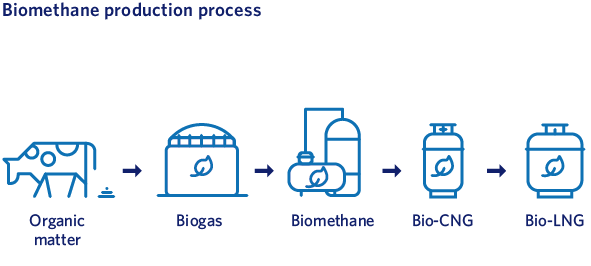
The draft Biogas Roadmap establishes a biogas production target of 1.41 TWh per year in 2030. At the European level, for that year it is expected that 10% of the total consumption of natural gas in the EU will come from biogas
There are currently four biomethane projects in the MRG network:
- Guadalix de la Sierra
The project aims to develop a livestock and agro-industrial waste recovery plant in Guadalix de la Sierra. In this case, Madrileña Red de Gas is leading the development of a project that aims to provide a complete solution for more than 20,000 tons of cattle slurry generated annually in the municipality.The project is being studied from an environmental, energy and agricultural point of view, where the municipality council continues to work on the development of an energy community to accommodate the project.
Two uses of biogas are envisaged:
- Direct use in a cogeneration plant to produce electricity. This alternative opens the door to the creation of an energy community in the municipality, supplying the neighbors with renewable electricity.
- Through an upgrading process, the biogas produced will be purified and compressed to produce biomethane. This can be used as natural gas for vehicles or injected into the natural gas grid.
- Cubas de la Sagra
Direct use in a cogeneration plant to produce electricity. This alternative opens the door to the creation of an energy community in the municipality, supplying the neighbors with renewable electricity.Through an upgrading process, the biogas produced will be purified and compressed to produce biomethane. This can be used as natural gas for vehicles or injected into the natural gas grid.
- Landfill with biogas production
In one of the municipalities where MRG distributes natural gas, a decommissioned landfill site now produces biogas.It is at this stage, when the landfill is already closed (closed and sealed), that biogas recovery takes place during the process of anaerobic decomposition of the organic waste in the landfill.
To recover the biogas from the landfill, a gas collection system consisting of pipes and wells is installed. After collection, the biogas is transported to a treatment plant where pollutants are removed and it is converted into biomethane, which can be used to produce electricity, injected into the grid or used as vehicle fuel, as discussed above.
MRG received a request from the company that manages this landfill to be able to inject this biomethane into the natural gas network. After studying the consumption in the area, it was confirmed that the network would be able to absorb the amount of biomethane produced. MRG will therefore manage the injection point and the new distribution infrastructure that will be necessary to connect the landfill to the natural gas grid.
- Biogas production plant in the north of Madrid
As in the case of the Cubas de la Sagra plant, there is another project for the construction of a biomethane plant in one of the municipalities in our network. The developer requested a study of the capacity of our network to absorb the expected production.

